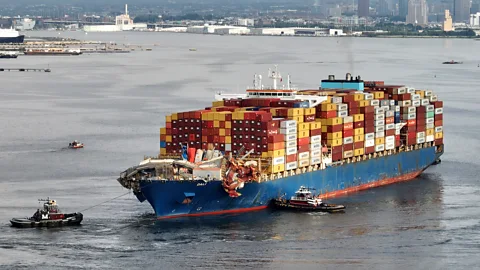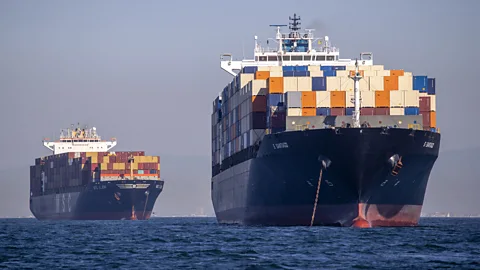The obvious idea that slashes shipping's climate impact
 Getty Images
Getty ImagesA motto in much of the shipping industry is "sail fast, then wait" – which can be an expensive and wasteful way of travelling. Some ships are making the bold move of slowing down to save money and emissions.
A giant containership traffic jam was swelling in the waters off California. In late 2021, demand for goods had exploded as Covid-19 restrictions eased and the world began – slowly – to return to normal. The ports of Long Beach and Los Angeles couldn't cope with the sudden influx of vessels from Asia.
By 9 November 2021, there were around 100 ships waiting to dock. Some had been stuck in the queue for more than a month. But then port officials had an idea. If vessels departing Asia knew their place in the queue, they might be able to time their arrival to coincide with when a berth was actually ready for them – rather than steaming head-first into a traffic jam. So, the ports started giving incoming ships a queue number.
What happened next was extraordinary. Vessels began sailing roughly three or four knots slower on average across the Pacific Ocean, easing the congestion problem – and incidentally saving around 460,000 tonnes of carbon dioxide equivalent (tCO2e) of emissions, according to Xeneta, an ocean and air freight analytics service.
"It was a particular situation," says Emily Stausbøll, an analyst at the company. "It was looking increasingly stupid to have hundreds of ships waiting outside Los Angeles."
What if the shipping industry could implement slower sailing like this more widely, by default – as a climate measure, not just an emergency measure?
"By reducing the speed by 10%, maybe by a mile an hour, you can reduce the emissions by around 20%," says Grant Hunter, director for standards, innovation and research at Bimco, a shipping industry association.
But slowing down comes with logistical and economic challenges. One maritime technology is now looking to solve these, helping ships save fuel and money without delaying shipping times.
Every year, shipping accounts for around 2% of global carbon dioxide (CO2) emissions – more than the entire annual CO2 output of Germany. Many of today's ships still use a particularly dirty fossil fuel called heavy fuel oil (HFO) in their engines, though some regions are introducing bans on their use (see factbox: Arctic fuel).
There are efforts to transition to cleaner alternatives, but this is expected to take many years. It means there's a rush on to find other ways of improving efficiencies right now. Some say that slower sailing is part of the answer.
It was a presentation at an industry conference that first introduced Pia van Wyngaard to a concept called Blue Visby Solution. The head of chartering for CBH, a grain growers' cooperative in Australia, listened intently as the speaker described how the system could help ships time their arrival to busy ports instead of racing there and having to wait at anchor for hours or even days before docking. This behaviour is so widespread in shipping that it has earned a nickname: "sail fast, then wait".
If ship operators and cargo owners can be reassured that their ship will have immediate access to a place for loading or unloading upon arrival, then there is no real need for haste. "I thought to myself that it was a great idea," recalls van Wyngaard. It wasn't long before her company had partnered with Blue Visby Solution in an effort to set up a real-world trial of the system.
"Sail fast, then wait" has become common largely because of the economic incentives it offers to big companies, explains Hunter. In short, it helps shippers guarantee their ship will be in place when needed. If the journey takes longer than expected and a coal exporter is left waiting for a late-arriving cargo vessel, for example, that can be expensive. "They don't want to have to shut down production at a coal mine, which would cost huge sums of money. It's much cheaper to have ships waiting at anchor," he says.
The same principle applies to all kinds of cargo. Electric vehicle components, say. If a cargo ship misses its slot to unload at port and the components arrive late at the factory, then cars don't get built on time and customers are left waiting. That could have negative consequences for multiple businesses, not just one.
Arctic fuel
One of the dirtiest forms of shipping fossil fuel, heavy fuel oil (HFO) is being banned in Arctic waters.
The International Maritime Organization's ban comes into force on 1 July 2024, but it will be several years before all ships in the area are prevented from using the fuel due to regulatory loopholes, environmental campaigners say.
Burning HFO releases large quantities of pollutants including black carbon, which accelerates sea ice melting.
The smooth running of supply chains tends to dictate how a wide range of companies and systems function, especially in the transport sector. Avoiding delays is so desirable that the mantra of "sail fast, then wait" is actually specified in some of the legal agreements signed by ship operators.
And yet there are other ways of doing things. "We aim to slow down the ships when there is congestion at the port," says Pekka Pakkanen, executive vice president for shipping solutions at Napa, one of the maritime industry firms behind Blue Visby Solution.
The system tracks shipping traffic in and out of a port in order to forecast the ideal arrival time and sailing speed, Pakkanen explains. Weather conditions that could affect the ships' movement are factored into these calculations. The method is currently most applicable to bulk vessels, which move large consignments of things like grain, stone and coal, since these ships are especially prone to the "sail fast, then wait" approach. Conversely, container ships tend to operate a bit like buses – sailing on predefined routes with ports of call set to a reasonably tight schedule, says Pakkanen: "When things are working normally, it is already close to optimal."
He and his colleagues have run computer simulations using data from thousands of bulk vessel voyages, to test whether slight reductions in speed really would cut emissions. The results have been promising, but the team only performed a real-world trial for the first time in March and April 2024, when two grain ships chartered by CBH sailed under directions from the Blue Visby Solution system.
Based on comparisons with computer models of the ships sailing the same routes but at slightly faster speeds, CO2 emissions from the real-world voyages were between 7.9% and 28.2% lower. The exact number can be affected by the size and type of ship in question, and the weather conditions encountered en route, among other factors, according to Blue Visby Solution. The calculation for emissions reductions also depended on how fast the digital versions of the vessels were set to sail in the simulation, which ran concurrently to the real-world voyages.
"I think it's quite incredible and it shows the opportunities that are out there through efficient operating of vessels," says van Wyngaard. The slower sailing saved money as well, as less fuel was burnt. However, a cost was incurred by prolonging the sailing slightly, resulting in an approximate “net balance”.
The only slight hiccup occurred when one of the masters on one of the trial voyages was "a little bit surprised" when orders to sail slower came through, says Pakkanen. According to Blue Visby Solution, the master in question required instructions from another party in the trial, delaying execution of the order. (CBH denied that such a communication hiccup had happened.) Communication is key for getting this system to work as intended, explains Pakkanen, but overall he says the trial was a success.
"We've got to share these good news stories to demonstrate things can be done like this," says Hunter, who wasn't involved in the trial.
 Getty Images
Getty ImagesThe concept of sailing slower is not new and there are other ways of implementing it. But Pakkanen points out that the premise of Blue Visby Solution is to ensure the operational availability of ships. If you were to simply put a speed limit on all vessels, yes, they would slow down – but that would also constrain the amount of cargo they could transport within a given time period. Blue Visby Solution tries to be more precise by converting waiting time into sailing time so that the transportation process doesn't actually take longer overall. The ship just sails at exactly the right speed to glide into port when a berth is ready.
There are challenges to ensuring wide adoption of this approach, however. "There will always be somebody who would deviate and profit by going faster than the others," suggests Dagmar Nelissen, senior researcher and manager of shipping at CE Delft, an environmental consultancy in The Netherlands. She notes that new regulatory pressures to reduce emissions might have a broader effect on the industry in terms of encouraging slower sailing.
Michelle Wiese Bockmann, principal analyst at the shipping data firm Lloyd's List Intelligence, says ship operators will have to be convinced of the economic advantages of any voluntary scheme to reduce speeds. "If it costs anyone money, it won't happen. That's how shipping works," she says.
However, Blue Visby Solution is "a great idea", she adds, that could work if those running the system are able to ensure benefits to the entire supply chain. And she notes that ship owners might reduce fuel consumption in other ways, too. They could use wind-capturing devices or paint smoother coatings on ships' hulls, which help them slip more easily through the water. Or, they could adjust routes so as to avoid tidal currents and weather that might force a ship to use more energy to get to its destination.
The bigger picture in shipping right now, though, is that there are some pretty hefty barriers to slow sailing. Because of Houthi attacks on vessels in the Red Sea, hundreds of commercial ships are choosing to sail thousands of miles further than usual when transiting between Asia and Europe. Currently, for example, many are navigating around the entire continent of Africa, rather than heading through the Suez Canal, which connects the Red Sea to the Mediterranean. Given the extra distances involved, ships are sailing faster than usual in order to make up the time. That means a significant increase in emissions, perhaps around 38% per voyage, according to industry analysis.
The longer journeys also mean that there is less capacity available across the world's commercial shipping fleet, since vessels are so busy getting to their destinations. That pushes freight rates up – which in turn encourages ships to sail faster still, not slower, says Stausbøll.
These big economic forces have a giant impact on shipping. It takes a lot of ingenuity to carve a way through and insist that efficiency should always be the priority.
--
For essential climate news and hopeful developments to your inbox, sign up to the Future Earth newsletter, while The Essential List delivers a handpicked selection of features and insights twice a week.
